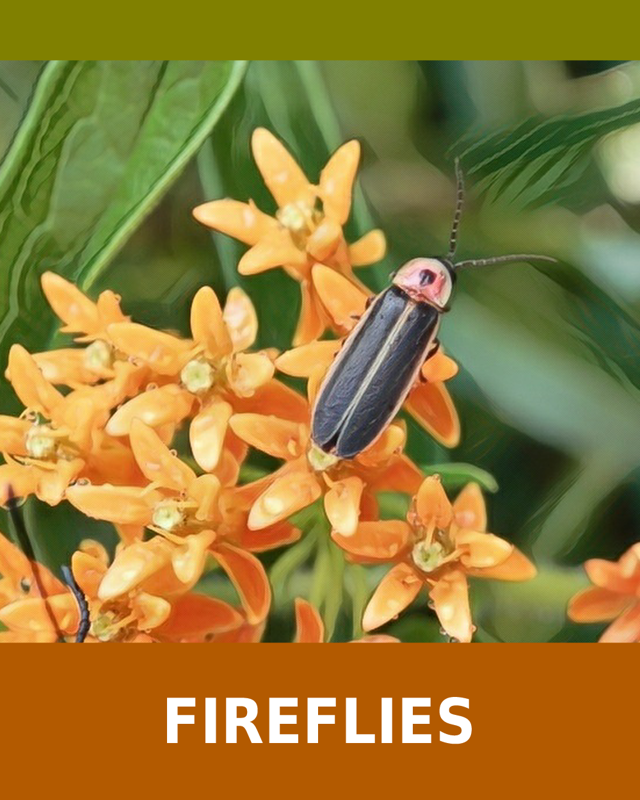 Fireflies
Fireflies
“Lightning bugs” or “fireflies” are actually beetles, nocturnal members of the aptly named Lampyridae family. Fireflies have special cells that, when the insects takes in oxygen, combine it with a substance called luciferin. This chemical process takes place in dedicated organs located under the fireflies’ abdomens and produces the light. Fireflies flash their light in patterns that are unique to each of the 2,000 species of firefly. They are communicating with their light, each blinking pattern an optical signal to a potential mate.
Sadly, as with so many of the Earth’s creatures, fireflies are disappearing all over the world. The clearing of forests, the destruction of wetlands, the use of toxic chemicals in agriculture and on residential lawns and gardens are all to blame. But the lovely firefly may suffer from something we might not think about - light pollution. It is likely that light from development and traffic may contribute to the firefly’s decline. Ambient light may be responsible for reducing firefly numbers by disrupting their mating signals, making it harder for them to find mates and breed.
What You Can Do
You can support firefly populations by following these simple steps. If you make your property or garden a firefly haven, the beauty of their light will more than repay you for your time and effort.
DO NOT CATCH THE FIREFLIES
Adult fireflies live only long enough to mate and lay eggs. Catching fireflies in glass jars is a nostalgic pastime for children on a summer’s evening, but how sad it is to waste one precious moment of a firefly’s brief existence trapped in a glass prison. Let them find their mates and complete their life cycle without disturbance.
KEEP YOUR BACKYARD IN THE DARK
Turn off exterior lights and remove even solar garden lights. If you have bright interior lighting, draw your drapes and lower your blinds at night.
LEAVE ROTTING LOGS AND LEAVES ON THE GROUND
Provide firefly larvae the conditions they need to grow to the adult, breeding stage. Allow some of the branches and leaf litter that fall naturally from the trees on your property to remain under the trees. Or cut them up and tuck the logs into your garden. Use bark mulch, preferably large nuggets, around your plantings to create a thick layer of organic, moisture retaining material.
CHOOSE PLANTS THAT CONSERVE MOISTURE
Solomon’s Seal, iris and hydrangea are a few plants that shade the ground beneath them. To create even more shade for the fireflies, plant low growing plants like wild ginger under the taller plants. Beds thickly planted in this way are like mini jungles, perfect for not only fireflies, but also toads and other moisture loving animals.
CREATE A WATER GARDEN
Any source of water will bring fireflies to congregate. A water garden will attract them and if you plant the edges of your pond with bog plants and keep it moist, the fireflies will stay and hopefully breed there. Chemically treated ponds and pools are not a natural environment for anything. A balanced water garden does not need chemicals.
DO NOT USE PESTICIDES
Pesticides and weed killers have had their effect on firefly populations. (It is widely believed that their use has also negatively impacted the honey bee.) Firefly larvae may eat insects that have been poisoned after eating plants that have been sprayed. The larvae are then poisoned as well.
USE NATURAL FERTILIZERS
Artificial chemicals rarely mix with nature, and many of the harmful chemicals found in pesticides are also found in fertilizers. It is very possible that chemical fertilizers harm firefly populations and the populations of other beneficial insects. Your garden can flourish beautifully with natural fertilizers such as compost. And fertilizing your lawn just makes more work for you and costs you and the Earth more in gasoline.
DON’T OVER-MOW YOUR LAWN
Fireflies stay mostly on the ground during the day and fly at night. Frequent mowing disturbs them. Fireflies prefer to live in long grasses. So mowing less often and leaving some areas of long grass may increase their numbers in your yard.
PLANT TREES
A firefly habitat needs trees to create shade. Shade and low light areas give the fireflies more time to find a mate. Fast-growing shade trees include Red Maple, River Birch, Tulip and most pine trees. Also, if left to accumulate, leaf litter and the fallen needles of pines will provide a habitat for the worms and slugs that firefly larvae eat.
SPREAD THE WORD
As with all animal issues, be an advocate. Let your friends and neighbors know that if we don’t take action now, fireflies may become just a memory of summers gone. You can set an example for your neighbors when you create a backyard sanctuary for wildlife. If only one of them follows your lead, you will have helped not just the fireflies, but also the other creatures that live around us.
 Fireflies
Fireflies